Director Timmermann is a renowned climate physicist. He spent his time as a researcher at the Max Planck Institute for Meteorology in Germany, the Royal Dutch Meteorological Institute in the Netherlands, the International Pacific Research Center, the lnstitut fur Meereskunde at the University of Kiel in Germany and most recently the University of Hawaii. Early this year, he moved to Pusan National University (PNU) to join IBS. Director Timmermann presents his vision for the research center; flexible thinking, continuous communication, and flat organizational culture. On an early summer day with a sprinkling of rain, we met with Director Timmermann at PNU, which offers an exotic ambience with palm trees, to find out his goals and determination for the new center, as well as his story as a scientist.
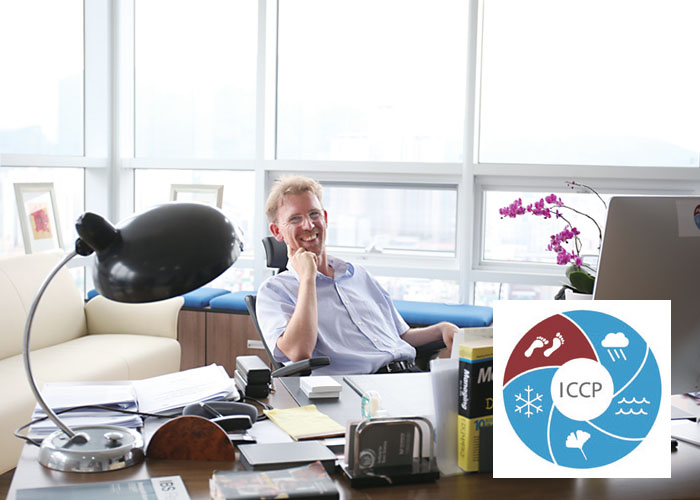
▲ The IBS Center for Climate Physics (ICCP), the very first earth science research center of the Institute for Basic Science (IBS), has a unique logo. In the Center of what looks like an aperture it says ICCP, the acronym of the Center's name, and the five surrounding segments include images of a rainy cloud, waves, a ginkgo leaf, a snowflake, and human footsteps.
Director Axel Timmermann of ICCP says: "The five images represent the atmosphere, hydrosphere, biosphere, cryosphere, and the anthroposphere. Footsteps, which represent the anthroposphere, are colored red while the other four natural components are colored blue. This logo symbolizes the philosophy, identity, and goal of our center, which is to take a holistic approach to climate change and its interaction with us humans."
From El Nino to climate-induced human migration
Director Timmermann was recently awarded the Milutin Milankovic Medal at the European Geosciences Union (EGU) General Assembly 2017 in Vienna, Austria. Milutin Milankovic was a Serbian astronomer who made significant contribution to the understanding of past climate changes by discovering the main mechanism that drives ice ages. Since 1993, the Milutin Milankovic Medal is one of the highest honors bestowed by the EGU upon scientists working in the field of climate change and modeling. The director's medal sits by the window of his welcoming office.
"I've worked on several aspects of paleoclimate over the past fifteen years. I searched for what drives ice ages and wrote a number of papers dealing with the synchronization between the northern hemisphere and the southern hemisphere glacial variability. I've also developed numerical computer simulations on glacial cycles. This is a rapidly evolving area. I believe these are the main reasons why I received the Milutin Milankovic Medal, as my contributions to understanding past climate change were recognized."
He earned his PhD at the Max Planck Institute for Meteorology where he conducted research on El Nino-Southern Oscillation (ENSO), an ocean atmosphere climate phenomenon. He studied El Nino, climate variability, and large-scale ocean dynamics since the 1990s and published a paper on ENSO in Nature in 1999. His paper is the second-most cited paper written on the topic of El Nino since 1990. "(My paper published in 1999) is the first study to address how this natural climate mode, El Nino, responds to the increase in greenhouse gas concentrations. It triggered a lot of follow-up studies. In particular, in the last ten years this field of El Nino under global warming has become very popular. Many more papers were published with more sophisticated climate models. But I am still very surprised and proud of the fact that most of these studies that are being published right now support my conclusion from 1999," the director added.
The director then spent his time as a postdoctoral researcher at the Royal Dutch Meteorological Institute in the Netherlands studying ice age cycles. After spending some time at the International Pacific Research Center of the University of Hawaii, he moved to the University of Kiel, Germany in 2001 where he launched a research group at the Institut fur Meereskunde which studied the mechanisms and predictability of rapid climate change. Since 2004, he worked as a professor at the Department of Oceanography at the University of Hawaii conducting research on past climate changes. Climate change modeling and simulations are Director Timmermann's key research areas. Since the 2010s he has mainly spent his time studying glacial dynamics and human migration. His study, published in Nature last year, used computer climate model simulations to understand Homo sapiens' migration. It has received considerable attention from both academia and the general public. He posed the following questions to us.
"Early modern humans, called Homo sapiens, originated in Africa. In that sense, all humans, including you and I, came from Africa and carry a little fraction of Neanderthal genes. This shows that our Homo sapiens ancestors may have interbred with Neanderthals some 30,000 to 40,000 years ago. So, the questions are what started this big human migration and why did Homo sapiens leave Africa?"
According to Director Timmermann's calculations the answer to these questions can be found in the longterm variations of earth's orbit and axial tilt. By forcing a climate model with these astronomical changes, Director Timmermann and his team were able to simulate 20,000 year vegetation cycles in northern Africa. Almost every 20,000 years a green corridor opened from Northern African into Asia, which animals and Homo sapiens crossed back and forth. His work has implications for understanding latest findings in paleo-anthropology, archeology, and paleo genetics. The director explained: "It sounds obvious, but humans cannot survive without food. Our computer models show that vegetation changes triggered the migration of animals, which subsequently led to the migration of Homo sapiens. We developed a mathematical model that describes human dispersal in the presence of time varying climate conditions."
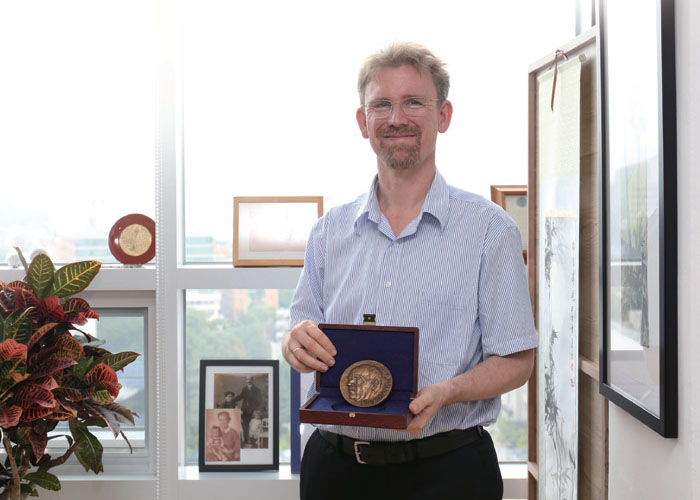
▲ Director Timmermann is holding the Milutin Milankovic Medal that he received in
Vienna,
Austria at the end of April this year
Future climate change depends on Antarctic ice sheet and ocean acidification
The role of climate research goes beyond a academia. Its social impact is immense as we are facing the crisis of Global Warming. Director Timmermann also emphasizes the social role and responsibility that climate research should fulfill. He was a lead author of the Intergovernmental Panel on Climate Change (IPCC) Fifth Assessment Report from 2010 to 2014. IPCC is the leading international body for the assessment of climate change set up by the World Meteorological Organization (WMO) and the United Nations Environment Program (UNEP). When asked about the Fifth Assessment Report, he physically handed over the impressively heavy and comprehensive report, which summarizes and assesses the current knowledge of past and future climate change. He contributed to the report by writing numerous sections in the paleoclimate chapter, such as those focusing on paleo El Nino, paleo monsoons, earth s y stem sensitivity, and ice sheet-climate interactions.
"The IPCC Report is the basis of political decisions that are being made internationally. The Paris accord was essentially based on the science that is in this report and its predecessors. Our decisions on how we approach CO2, emissions will determine whether we are going to have a moderate warming or a very strong warming. The good news is that we can still determine the magnitude of future climate change by our political decisions," the director says.
He further explained that if greenhouse gas emissions remain at a business-as-usual level, the global temperature is expected to go up by four degrees Celsius and the sea level will rise one meter by 2100. What is more, the global sea level could even rise one additional meter if ice sheets in the Antarctic become unstable. The director said "Changes in the Antarctic ice sheets are the biggest wild card to sea level rise." If the sea level goes up by two meters, large low-lying regions like inland Gimhae will be flooded and several thousands of square kilometers will go under water in places like Bangladesh or the East Coast of the United States. "What happens to the ice sheets of the Antarctic is what researchers in our field are most concerned about. So, we are determined to continue research on this topic," he added.
There is another reason why CO2, emissions are critical to climate change; CO2, causes ocean acidification. A large amount of CO2, absorbed by the ocean changes the chemistry of sea water, which leads to higher acidity. This brings negative impacts to the marine ecosystem, such as hindrance to the calcification of marine organisms - especially crustacean's calcification, which is essential to the formation of their hard shell or crust.
"Currently we understand how ocean acidification occurs on a global scale, however the level of understanding remains low on a regional scale, for example in East Sea or West Sea of Korea. For Korea, this is a particularly critical issue as it has a direct impact on the nation’s aquaculture and fishery, which in turn affects marine food supply. In order to address this important area of research, our center has recruited one prominent geochemical modeler who studies the effects of ocean geochemistry and acidification. This study will be very relevant to Korea, which relies heavily on marine food resources."
ICCP will conduct research to understand climate-driven sea level rise, ocean acidification, and the drivers of past and future climate changes. The center will use supercomputing technology to produce research outcomes with regard to changes in the Antarctic ice sheets and sea level rise, which were not dealt with sufficiently in the last IPCC report. Other interesting topics will be explored as well. "One of the observational groups to be introduced at the ICCP will retrieve and analyze the samples of marine sediments cores as well as stalagmites from caves. This will allow us to reconstruct climate changes in Korea over the past hundreds of thousands of years and better understand the drivers of climate change."
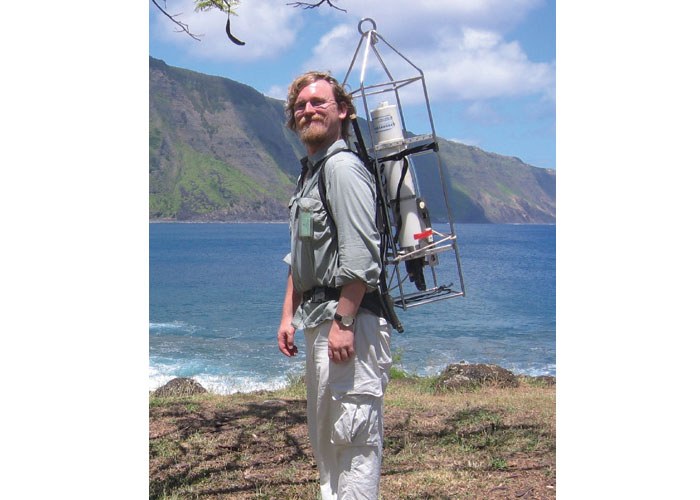
▲ While working as a professor at the University of Hawaii,
Timmermann explored the islands of Hawaii to study climate change.
Envisioning a research space with open commumcation
Director Timmermann is now settled in Busan after having spent a long period of time in Hawaii. To the question of whether it was difficult to move from Hawaii to Korea, he answered with a hint of enthusiasm: "I feel that the current funding environment in the U.S. heavily supports application-driven science, not basic science. Particularly for climate research, everyone always asks 'what you can do for our region?' But there are so many big global questions that require a much more fundamental approach in climate research, such as problems in the Arctic and Antarctic. With the possibility to lead a center at IBS, well, for basic science, was very much tempting. (I wanted) to enjoy the freedom to explore big ideas."
He presents a vision of introducing an open communication environment to the center. He believes that the key to understanding the big picture beyond individual research fields is communication among scientists. Painting walls with bright colors and having lounge areas in the center are part of his efforts to brighten the mood and encourage researchers to communicate and share ideas freely. He wants to create a horizontal organizational structure.
ICCP receives support from PNU and the Busan metropolitan government. The Korea Ocean Satellite Center of Korea Institute of Ocean Science & Technology, which will relocate to Busan in the second half of this year, and the APEC Climate Center are among the institutions in Busan which actively engage in climate studies. Director Timmermann plans to carry out joint research with them in ocean observation and climate modeling. Five research groups corresponding to five segments of the center's logo will be set up: earth system dynamics (climate dynamics), hydroclimate, paleoclimate, earth system predictability (climate modeling and predictability), and climate/human interactions. A supercomputer with over 800 Tflops capability will be added to the center for advanced climate research.
"Korea is strong in climate statistics and climate theory, however it has room for improvement in the climate modeling field due to a lack of supercomputing power. Furthermore, climate research-related communities in Korea - atmospheric science, oceanography, and geochemical modeling - are separated from one another. However, the global climate research is now focused on integrating these different components - atmosphere, ocean, carbon cycle, geochemistry, and so on. I hope that the ICCP can make big contributions in terms of putting Korea at the forefront of international climate research by training a new generation of scientists to adopt a broad perspective and eventually become earth system dynamicists."
The ICCP will hold an international conference on "Climate Change and Human Migration" at the Paradise Hotel, Busan from November 27th to December 1st this year. At the conference, climate physicists will be joined by experts from various fields including paleogenetics, food security, climate justice, sea level rise, water management, to discuss how climate predictions can help resolve future humanitarian crises.
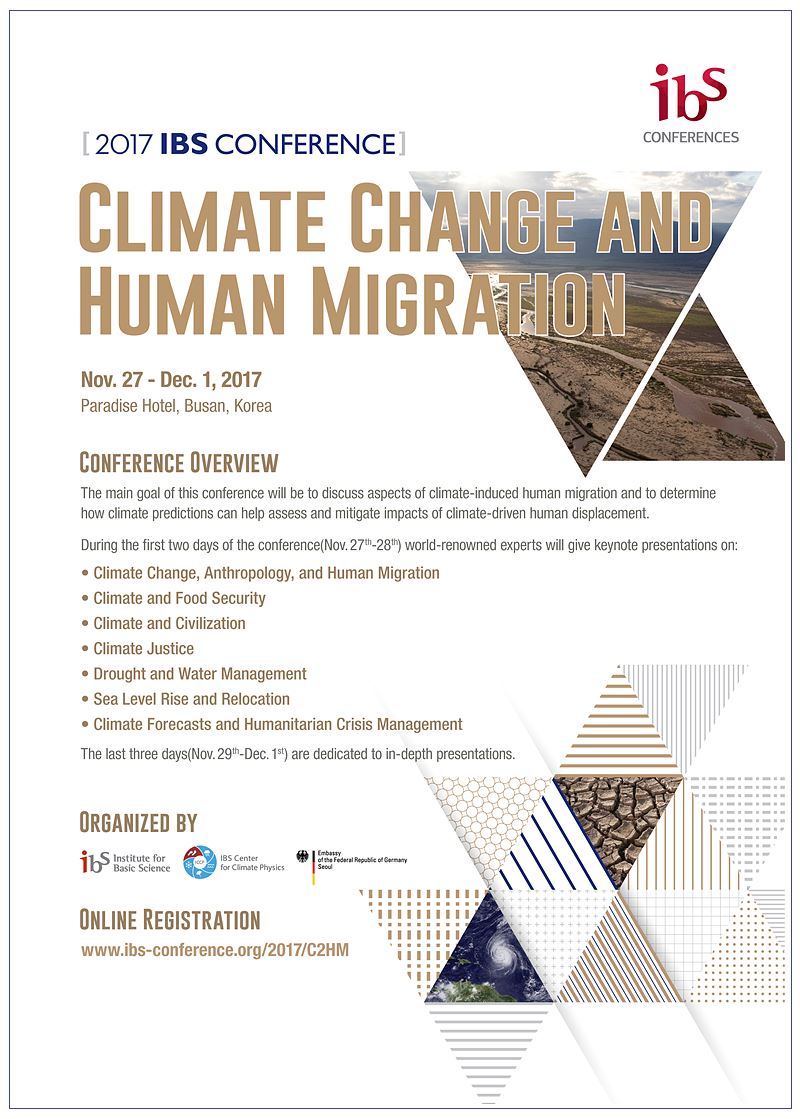
▲ Poster of Climate Change and Human Migration International Conference
to be held
by Center for Climate Physics at Paradise Hotel Busan from November 27th to December 1st, 2017.
Passion for Science and piano, the never-ending source of inspiration
Towards the end of the interview, Director Timmermann played the grand piano in his office. Beautiful melodies lingered in our ear as mist over the Geumjeong Mountain peaked through the window. His office was transformed into a cozy concert hall. His love for piano matches his passion for science. When we mentioned his well-known piano skills, a humble smile appeared on his face. He described science and music as his two big passions in life.
"Music is interesting in a sense that it opens different parts of my brain. Very often when I improvise I have no idea where it comes from. I am in a state of mind that is unexplicable to me. But at the same time I am very relaxed and my ideas and thoughts flow freely. So it's a moment of creativity. I try to carry over some of these experiences to science. When I am looking for a solution to a difficult scientific problem, I try to put myself in a similar state of mind, which leads very quickly to elegant answers. I believe such creativity allows me to come up with new findings, which makes my surrounding a happier place," the director says.
Timmermann names Professor Klaus Hasselmann, the Founding Director of the Max Planck Institute of Meteorology, as his role model. He said Professor Hasselmann taught him to ask questions that haven't been asked by others. This is how pioneers of science are born, rather than those who simply follow other researchers, the director says.
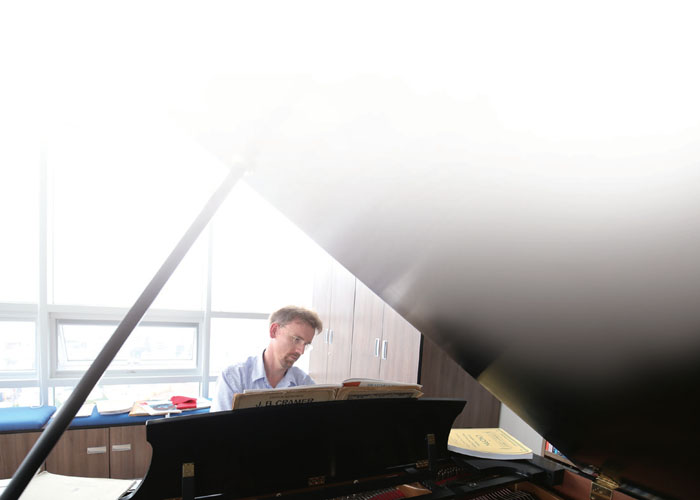
▲ "Music is interesting in a sense that it opens different parts of my brain. Very often when I improvise I have no idea where it comes from. I am in a state of mind that is unexplicable to me. But at the same time I am very relaxed and my ideas and thoughts flow freely. So it's a moment of creativity. I try to carry over some of these experiences to science I believe such creativity allows me to come up with new findings, which makes my surrounding a happier place."


 thumb.jpg
thumb.jpg
















